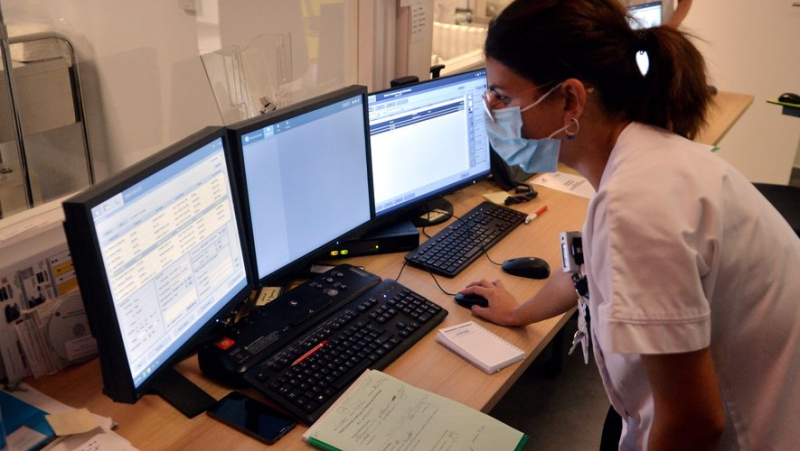
Reading a scintigraphy at the ICM-Val d'Aurelle, in Montpellier. Midi Libre – MICHAEL ESDOURRUBAILH
With 433,000 new cases and 162,400 deaths each year, cancer, which is the subject of a world day of fight, this Tuesday, February 4, is one of the most frightening diseases. It is also a still taboo condition that results in a loss of employment for one in five people.
“Significant advances in research, diagnosis and treatment”: in its “Overview of cancers in France”, the National Cancer Institute (INCa) aims to bring hope, while World Cancer Day, this Tuesday, February 4, is marked by good news for certain prognoses and treatments, but persistent obstacles: one in two cancers could be avoided.
433,000 new cases of cancer in France in 2023, 33,487 in Occitanie
In France, 433,000 people learned in 2023 that they were suffering from cancer. The figure “testifies above all to the demographic evolution of our country”. In 1990, the figure stopped at 216,130 cases.
Number of deaths: 162,400.
Cancer is “the leading cause of death in men”, the second most common in women” (behind myocardial infarction).
Median age of diagnosis: 70 years in men, 68 years in women.
Prostate cancer is the most common male cancer (24% of cancers). Breast cancer (33%) is the most common in women, but lung cancer (14% of cases, 9,900 deaths) and pancreatic cancer (9% of cases, 6,300 deaths) “are increasing in a worrying manner”.
It is lung cancer that is the most deadly in France: 30,400 deaths.
Occitanie represents 9.4% of cancers diagnosed in France, or 33,487 cases per year. Broadly speaking, “Occitanie does not present any significant differences compared to metropolitan France, all locations combined”, indicates Santé publique France.
Prostate, melanoma, breast: those that are best cured
Lung, pancreatic, esophageal, liver, central nervous system cancers, as well as acute and myeloid leukemias, ovarian and stomach cancers, are described as having “poor prognosis”, their five-year survival rate remains low.
This does not mean that they do not benefit from progress: +7% five-year survival rate for pancreatic cancer between 1990 and 2015, for example, but barely 11% for survival.
In this 1990-2015 interval, the greatest progress is for prostate cancer (+21 points), which remains the cancer with the best prognosis: 93% survival at five years, ahead of cutaneous melanoma (93%, +11 points) and breast cancer (88%, +9 points).
200% Deposit Bonus up to €3,000 180% First Deposit Bonus up to $20,000Melanoma, pancreas, lung… those that are increasing and those that are decreasing
In men, cancers of the “lip, mouth, pharynx” sphere (-2.6% from 1990 to 2023) are those whose incidence is decreasing the most, ahead of colorectal cancer (-0.3%) and lung cancer (-0.2%).
Conversely, the incidence increases, at the same time, for skin melanoma (+3.5%), pancreas and prostate (+2.3%), liver (+1.3%).
In women: the incidence of cervical cancers decreases by 1.4%. The highest increases are for lung cancers (+5%), pancreatic cancers (+3.3%) and liver cancers (+3.2%).
Childhood cancers: nearly 15,000 cases from 2014 to 2020
Pediatric cancers totaled 14,934 cases from 2014 to 2020, with high chances of survival: 83% at five years for those under 14, 82% for those aged 15-17.
Risk factors: what we know
“There are many risk factors for the development of cancers. They can be internal, linked for example to age or family history, or external, linked to our behaviour or our environment”, says INCa, which repeats that “nearly half of cancers could be avoided”.
Four main risk factors are identified: tobacco (involved in 19.8% of so-called avoidable cancers, it “weighs” 68,000 new cases of cancer in 2015), alcohol (8%), overweight and obesity (5.4%), an unbalanced diet (5.4%).
As a reminder, barely “28% of adults consume 5 fruits and vegetables daily”, recommendation of the health authorities.
The shortcomings of screening
17.2 million French women were eligible for cervical cancer screening in 2023, barely 59.7% of them participate in screening campaigns.
For breast cancer: 10.8 million eligible women, 46.5% participation.
Colorectal cancer: 17.9 million eligible people, and 34.2% of participation.
Care: €6.4 billion in hospital spending
With €6.4 billion in hospital spending for diagnosis, treatment and monitoring in 2022, cancer “has a heavy impact on hospital activity”, says INCa.
Surgery (418,342 people), chemotherapy (372,348 people) and radiotherapy (245,222 people, in hospital and in private practice) remain the trio of most common treatments. In 2022, 74,631 patients also benefited from immunotherapy, a figure that has been increasing since then.
Societal impact: one in five people lose their job
Five years after diagnosis, one in five people had lost their job, recalls INCa, which emphasizes that “cancer too often remains a taboo subject or one that is poorly understood in the workplace”.

